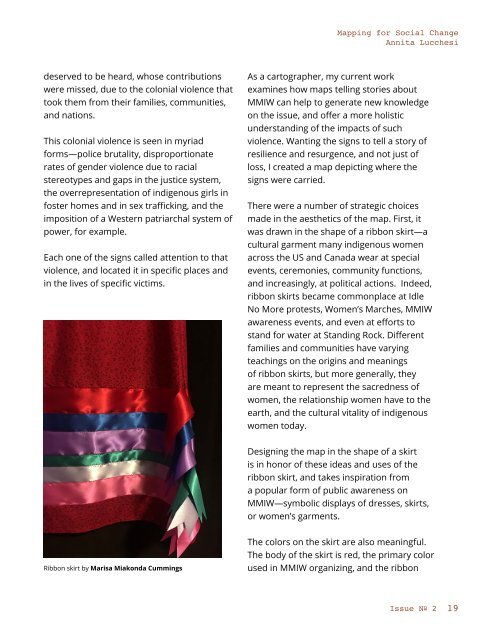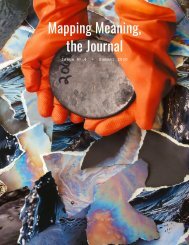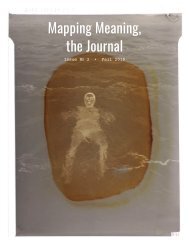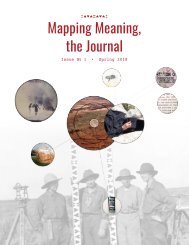Mapping Meaning, the Journal (Issue No. 2)
ISSUE SCOPE: Design Determines the Impact of Change
ISSUE SCOPE: Design Determines the Impact of Change
You also want an ePaper? Increase the reach of your titles
YUMPU automatically turns print PDFs into web optimized ePapers that Google loves.
<strong>Mapping</strong> for Social Change<br />
Annita Lucchesi<br />
deserved to be heard, whose contributions<br />
were missed, due to <strong>the</strong> colonial violence that<br />
took <strong>the</strong>m from <strong>the</strong>ir families, communities,<br />
and nations.<br />
This colonial violence is seen in myriad<br />
forms—police brutality, disproportionate<br />
rates of gender violence due to racial<br />
stereotypes and gaps in <strong>the</strong> justice system,<br />
<strong>the</strong> overrepresentation of indigenous girls in<br />
foster homes and in sex trafficking, and <strong>the</strong><br />
imposition of a Western patriarchal system of<br />
power, for example.<br />
Each one of <strong>the</strong> signs called attention to that<br />
violence, and located it in specific places and<br />
in <strong>the</strong> lives of specific victims.<br />
As a cartographer, my current work<br />
examines how maps telling stories about<br />
MMIW can help to generate new knowledge<br />
on <strong>the</strong> issue, and offer a more holistic<br />
understanding of <strong>the</strong> impacts of such<br />
violence. Wanting <strong>the</strong> signs to tell a story of<br />
resilience and resurgence, and not just of<br />
loss, I created a map depicting where <strong>the</strong><br />
signs were carried.<br />
There were a number of strategic choices<br />
made in <strong>the</strong> aes<strong>the</strong>tics of <strong>the</strong> map. First, it<br />
was drawn in <strong>the</strong> shape of a ribbon skirt—a<br />
cultural garment many indigenous women<br />
across <strong>the</strong> US and Canada wear at special<br />
events, ceremonies, community functions,<br />
and increasingly, at political actions. Indeed,<br />
ribbon skirts became commonplace at Idle<br />
<strong>No</strong> More protests, Women’s Marches, MMIW<br />
awareness events, and even at efforts to<br />
stand for water at Standing Rock. Different<br />
families and communities have varying<br />
teachings on <strong>the</strong> origins and meanings<br />
of ribbon skirts, but more generally, <strong>the</strong>y<br />
are meant to represent <strong>the</strong> sacredness of<br />
women, <strong>the</strong> relationship women have to <strong>the</strong><br />
earth, and <strong>the</strong> cultural vitality of indigenous<br />
women today.<br />
Designing <strong>the</strong> map in <strong>the</strong> shape of a skirt<br />
is in honor of <strong>the</strong>se ideas and uses of <strong>the</strong><br />
ribbon skirt, and takes inspiration from<br />
a popular form of public awareness on<br />
MMIW—symbolic displays of dresses, skirts,<br />
or women’s garments.<br />
Ribbon skirt by Marisa Miakonda Cummings<br />
The colors on <strong>the</strong> skirt are also meaningful.<br />
The body of <strong>the</strong> skirt is red, <strong>the</strong> primary color<br />
used in MMIW organizing, and <strong>the</strong> ribbon<br />
<strong>Issue</strong> N o 2<br />
19







